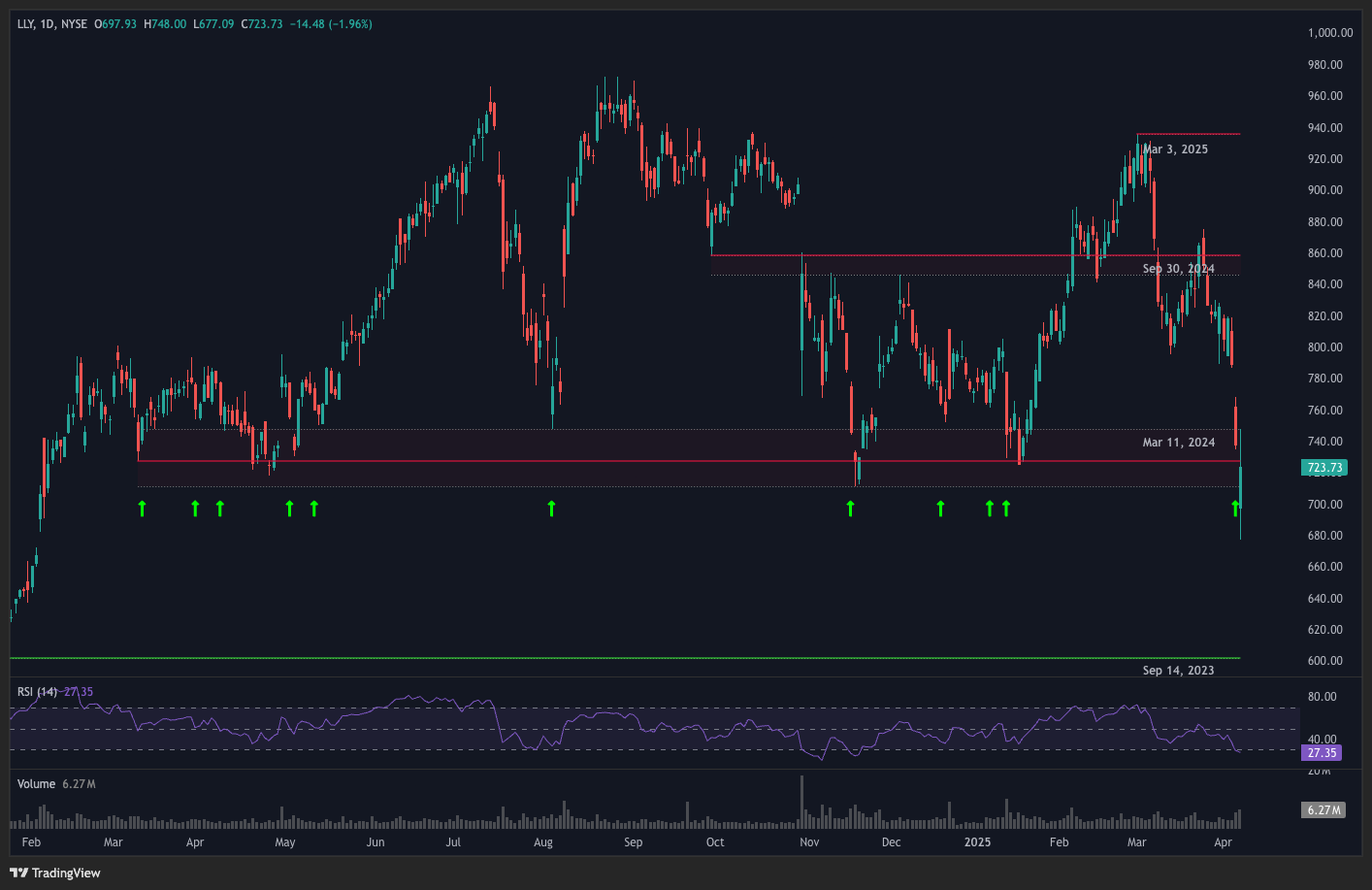Hot zone alert - April 8 2025
Your weekly guide to the the most promising trade setups in stocks, crypto, and currencies
A pretty great morning, friends!
Indices are up. VIX is down. The Mag 7 are all green. Life is peachy.
But, as you all know by now—one small misspeak… one errant rumor… and this all goes to sh*t. So no, news and vibes alone can’t get us through this.
Zones, however, can give you a better shot. And as you’ll see later, even the craziest of price actions can still adhere to zones.
So let’s get into it.
But first, a quick heads-up: Trading Places goes live next week! We’re finally opening up our online platform to beta testers—so keep an eye out for your invite.
New here? Welcome to Zone Alerts.
This is where we highlight stocks that are approaching key support and resistance zones and analyze where the action might lead.
These alerts help you zero in on high-potential setups while keeping risk management in check.
What’s in this issue:
• This week’s three new hot zones
• What are zones?
Here’s what our zone algo picked up for you this week:
Eli Lilly & Co. (LLY)
Healthcare • Drug Manufacturers - General • USA • NYSE
Up until about a year ago, LLY has been a very safe bet—the NVDA of pharma, as they say—a favorite among retail traders always looking to buy the dip, and for good reason.
But the back half of 2024 has not been kind to the stock. Since peaking at $972, LLY has been chopping around—forming and retesting zones along the way.
And now, thanks to Liberation Day selloffs, LLY is back at its March 2024 zone.
To its credit, this zone has performed admirably in the past—fending off all previous attempts to break below it.
But this retest might turn out a little different.
The Trump White House recently announced that Medicare coverage for obesity medications could be delayed—a major blow for Zepbound, LLY’s new weight-loss drug, which could reportedly rival Ozempic, Mounjaro, and Wegovy.
People having access to it through insurance would’ve been lucrative, to say the least.
With this setback, LLY is in a precarious position. Although RSI is already at oversold levels, selling pressure still appears to be growing.
If the stock doesn’t manage to overcome the March 2024 zone soon, we could see another sharp drop to the next zone down—September 2023—for a 15% return.
EOG Resources, Inc. (EOG)
Energy • Oil & Gas E&P • USA • NYSE
For most of the past year, EOG price action has been a swing trader’s dream—bouncing between the March 2011 and February 2013 zones, consistently offering 10–12% moves.
But since the new tariffs kicked in, EOG fell off a cliff. It broke its range and is already down about 15%.
Right now, EOG is at a support zone that has seen a lot of bounces in 2023 and 2024. Moreover, its RSI is at the high 20s—a level that has seen sharp reversals for the stock.
If the same thing happens this time, it could make a quick bounce—possibly filling that gap from April 3 to 4, which also aligns with its March 2011 zone.
However, if selling volume remains high, even this February 2011 zone might not hold. If that happens, we’re eyeing the March 2010 zone as a potential short target for 5-10%.
Apple Inc. (AAPL)
Technology • Consumer Electronics • USA • NASD
If there was a stock where you could understandably be a Panican, it’s this one.
That’s because AAPL could potentially be one of the biggest casualties of 47’s trade war, thanks to the sheer amount of components it sources from China.
As a result, the stock crashed nearly 20% in just three days.
It even came close to breaking down some more yesterday, which led to a few interesting price—zone interactions: the day’s low was in the February 2022 zone, the high touched the June 2023 zone, and it closed right in the December 2021 zone.
However, that looong wick can be a cause for concern—it shows that there are still sellers lurking around the June 2023 zone.
As of writing, the stock looks like it’s on track for another breakout attempt.
But as we’ve seen recently, a lot can happen in one afternoon. If AAPL’s push fails, the stock could easily go down to the April 2023 zone below—a 5-8% drop if it happens.
WTF are Zones, anyway?
Zones are key price levels where the market has reacted strongly in the past—such as sharp reversals or sudden swings.
They’re areas where actual supply and demand met in the past, and likely will meet again.
“Why are these significant?”
Well, it all comes down to three key principles. We like to call them The Principles of:
When I Dip, You Dip, We Dip (aka psychology)
Traders are aware that others are watching these levels (zones) too. With everybody paying attention, this creates a self-fulfilling prophecy where everybody acts in anticipation of everybody else’s actions.
Markets Gonna Market ¯\_(ツ)_/¯ (aka technical factors)
If the first price rejection at the top of a zone was violent, it’s likely that buyers who entered at that level are now holding losses.
But with each retest, the rejection weakens, as there are fewer buyers remaining underwater. This weakens that resistance (or support for all you short-sellers), and could eventually lead to a break through.
Killer Whales (aka institutional plays)
Big players need liquidity in order to place massive orders without moving the market against themselves. So they wait for these zones, knowing a lot of us small fry (retail traders) will come to play.
This allows them to buy low or sell high without causing a lot of waves.
But remember: Zones are NOT guarantees but rather regions of increased probability for market moves. So always, ALWAYS use proper risk management.
Trading Places: Launch coming soon!
Stop obsessively refreshing your charts like it’s your ex’s Instagram.
By combining historical patterns with real-time market data, Trading Places identifies zones and assigns probabilities to each one—helping traders spot potential plays with higher chances of success.
It automates all of the curation, chart-plotting, and alerting for you, so you can actually have a life (or at least pretend to)!
Stay tuned!
Disclaimer: This isn't financial advice. This shouldn’t be news to you.








